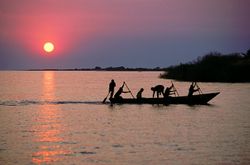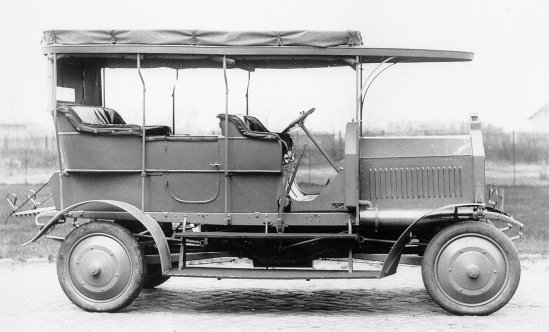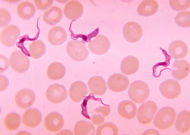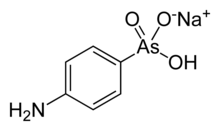|
Retrospect on the Development in 1907 of
the
Protectorate
Deutsch-Ostafrika, Contents: |
 Above : Fishermen on Lake Tanganyika. Below : Lake Tanganyika as seen from space June 1985. 
|
The German Colonial Atlas with Yearbook, edited by the German Colonial Society, Berlin 1908,
Retrospect on the Development in 1907 of the Protectorate Deutsch-Ostafrika with added comments.
'In 1907, the State Secretary of the Imperial Colonial Office, Herr Dernburg, visited German East Africa from August till October, and got to know not only our Protectorate, but also Zanzibar and the neighbouring English colony, and not just the coast, but also a part of the hinterland between Lake Victoria and Tabora. His Excellency Herr Dernburg was not the first of the higher German Colonial officials who have steered themseves into one of the colonies, for he had in the form of Herr Kayser, the first German Colonial Overseer, a forerunner. However, nobody in his position before him had visited the colony at such length and, above all, nobody had applied himself to it, to study and see through to the end all the colonial problems of the Protected territories at first hand, as the present leader of the central German Colonial Administration did.'
|
Note : In 1906, he changed to politics, initially in 1907 as the Prussian delegate to the Bundesrat, and then as State Secretary in the Reich colonial office. With him, German politics entered a fundamental reform of its direction. In the First World War, Dernburg participated in the establishment of "Deutsche Demokratische Partei (DDP)" and was an advisor for the Reich executive. He belonged to the Weimar National Assembly in 1919 and 1920, which drew up the new constitution, and from April until June in 1919 he served in the Scheidemann cabinet as finance minister and Vice-Chancellor of the German Reich. From 1920 to 1930 he was part of the Reichstag as a DDP member of parliament. |
|
'His Excellency Herr Dernburg has stated the result and gains of his journey himself in various places, first at the 25th year Jubilee celebration of the German Colonial Society at Frankfurt am Main on the 5th. December, and the last, in detail, at the Budget Commission of the Reichstags on the 18th. February. It could not be kept clandestine that between his opinion and the wishes to make the colony more useful, participating circles' long-borne differences of opinion had been asserted, but the Reichstag, however, which in the end, in association with the State secretary, has to determine the principles of German colonial policy, and with not a small part of the German public - perhaps even the prevailing majority - has, on the whole, accepted his view. This policy has been called friendly to the inhabitants and an uprising has been portrayed as likely, which the natives might be tempted into, as they would no longer have the feeling that a severe and harsh hand controls them.'
'The same reason was underlined by the Secretary of State for his policy for the indigenous population on the ground: he worried that a harsher and exaggerated severity might well drive the inhabitants to rebellion. The core of the opinions held by him can be gathered from the following sentences given utterance to in his speech of the 18th. February 1908:
"We must - and this is the foundation of our power - see to it in East Africa, that the reputation, which the administration possesses, by the sternness, with which it counters any confrontation of unruliness, by technical assistance for the railways, which, as you know, is still very much sidelined, and with a great deal of trust which it enjoys from the blacks, all be brought to bear at the same time. We must bring into being a strong, just, trustworthy administration there, and maintain, and above all make known to the people that they stand to gain from German rule. That is very difficult to instil into them, since the benefits which they have had until now have been very small compared to the disadvantages which the German administration has created for them, from their point of view, in respect of alteration of their customs, in taxation, regulations, and so on"In any case one can maintain that the Protectorate can only stand to gain when the topmost leader of colonial policy in the homeland is bestowing it with a visit, and besides, all the more significant, as it directs the attention of the domestic population to German East Africa, and the work put in there by 1956 Germans for the honour and to the advantage of the fatherland.'
|
Note : |
Dernburg-Wagen 1907 (Courtesy of DaimlerChryslerAG). 
|
'The white population has not risen in the last year at the same pace, as was the case before, but, all the same, there was a 7 percent increase, that is from 2,465 of 2,629. This figure, besides, does not indicate very much, and does not reveal that , for example, officials, soldiers and missionaries have only increased by a small number, whereas the gainfully employed inhabitants, we might say the breadwinners, have risen to around 25 per cent. The statistics imply that the figure for children has fallen by almost just as much. This striking fact finds a most clear explanation in the case where from the Moshi on Mount Meru district a large number of those Boer trekkers richly blessed with children, who had begun to settle themselves there, have emigrated to the neighbouring English colony. We do not know the number of the coloured population of German East Africa. In recent times, frequently, approximately 9-10 million were cited, which, perhaps, is on the high side than need be. Unfortunately, as far as we can see it in full, this indigenous population regresses in number. A severe loss was sustained from the rebellion, which began in August 1905, for wide areas in the south, and altogether perhaps 75,000 people in the year under review were reduced through war, crop failure, famine and epidemics. Otherwise, there is nothing to complain of about in the health situation of the protectorate.'
Note on sleeping sicknessThere was no real room for optimism at the time. The western area of Tanganyika, in particular near the lakes, had been suffering from an 'epidemic' of sleeping sickness, an illness which also ravaged neighbouring Uganda. Large outbreaks of this disease had occured in East Africa at the turn of the century (1896 -1910), and it was widely held that these were epidemics imported from West Africa or the Congo, rather than being endemic to the region. In fact, Robert Koch, who in 1904 had been to German East Africa to observe East Coast fever of cattle, had come again in 1906-7, to test the drug atoxyl. Atoxyl was so called by Antoine Béchamp,, who made it in 1859 by reacting aniline with arsenic acid, to denote its lesser toxicity when compared to arsenic. In 1906, Paul Ehrlich(1854-1915) and A. Bertheim(1879-1914) had discovered the structural formula of atoxyl.

Left : Trypanosoma |

Atoxyl. |

Glossina morsitans, mbun'go, |
Note : (contd).
Ehrlich had previously worked under Koch in Berlin and, having
broken new ground in
the selective staining of microorganisms, had successfully
stained Koch's
tubercle bacillus. It was the specificity of these histological
techniques which in
Ehrlich had given rise to the idea of a "magic bullet", that is to say
a
substance which
would be lethal only for the organism against which it was
directed.
Koch, therefore,
campaigned (along with other observers elsewhere, all
persuaded
by the results of experiments done by Thomas and Breinl, based
at
the Liverpool School of Tropical Medicine, such as Kopke,
Thiroux
and d'Anfreville, Martin, van Campenhout and others) against
sleeping sickness in German East Africa using this drug which,
whilst somewhat
efficacious, was found later to have serious side effects.
The first published description of sleeping sickness cases during
the
1900-1920 'epidemic', in the British Protectorate of East Africa,
now
Uganda, was made at the Church Missionary Society (CMS)
Hospital at Mengo in 1901. Thus it was that David Bruce and his
wife reached
Entebbe in March 1903, with Dr. David Nunes Nabarro (1874-1958)
and a sergeant technician, and met the remaining representative
of
the first commission, a young Italian bacteriologist, Dr. Aldo
Castellani. It was
Castellani who found the organism in cerebrospinal fluid of
patients
there with sleeping sickness. Shortly afterwards, the suspicion that it was
transmitted by the tse tse fly, in particular the fly Glossina
morsitans, to human beings was confirmed. The word ' tse tse'
(Kiswahili, mbun'go), is an Afrikaans word derived from Tswana.
For the famine which gripped the country despite the end of
the
rebellion, and
which had also been a feature of Uganda coinciding with the
building of the Mombasa
- Kisumu (Port Florence) railway line, commenced in 1896 and
completed in 1901, two contemporary missionary eye-witness accounts for German and British east Africa are presented atFamine in E. Africa.
As for war, sporadic unrest continued in the year, and required the
despatch of the
Territorial Force to quell it wherever it was necessary.
'A great difficulty in recent times was especially objectionable, namely that the coloured population of the plateau and the mountains are not willing, and not capable, of being enlisted for work in the lowlands. The question of labour is probably the main problem in the entire colony of German East Africa. Certainly, it is not an especially burning one at the present time, but with the natural expansion of plantation farming it will become more and more prominent. The colonial government, however, while it has discounted the enforced labour of the indigenous population through coercive measures, is not altogether consistent as to which measures it then means to resort to. From experts we expected a lot through the expansion of the railway network, because already now, in the protectorate, frequent 'migrant labour' (1) becomes facilitated by it, that is, because it might be possible, from the more populated inner country, to transport workers to the coast, or elsewhere, where they might be needed. Admittedly, it will take still take years before we can speak of a railway network in this protectorate.'
Railway construction'To be sure, in the last year, we have been brought the completion of the Daressalaam-Morogoro line. However, what does this 220 km signify against the total distance throughout of around 1,000 km from Daressalaam to Lake Tanganyika! The means for the Daressalaam to Morogoro stretch, as will be recalled, had already been put into place through a decision made at the Reichstag on the 16th. June 1904, and the first ground-breaking ceremony, as is known, was performed by the third son of our Imperial couple, Prince Adalbert. All sorts of adverse conditions, bad weather and labour shortage, insubordination, and the like, have for long delayed the railway construction. On the 9th. October, finally, the State Secretary, Dernburg, was the first to journey on the finished stretch. A railway line in German East Africa offers the best prospects, as attested to by the Usambara railway; they have, namely in the year under review, delivered a considerable surplus, so that the construction company has early on declared itself ready on the basis of these yields to embark upon yet more gradual construction. Admittedly, in this way, many years can go by before arriving at Mount Meru. At the same time, it is just as urgently required in Moshi district, the district of Mount Meru, to run a railway line where, according to the statistics, 386 white settlers are located, because the connection with the coast for trade supply, as for sales of produce, is desperately needed.'
|
Note : |
 Tanga Railway Station 1908/9 |
On the side of the Government, the significance, also the politics, of the white immigration, is it not underestimated? Certainly, they require support and safety in the first period, but a great number of the plantations, large and small, is, however, today, aside from the need for provision of work, standing on its own feet. In days gone by, as was the case still in 1895, elephant tusks made up half of the total produce of German East Africa. With caoutchouc, it is similarly declining. Therefore, the inhabitants must bear their concerns precisely through plantation, or small-lot farming, to obtain fresh income from exports. What to produce here to start with, which comes into question, is uncertain and depends, above all, on the particular worldwide economic conditions. India rubber certainly still stands at a high, whereas with sisal, it is going downwards somewhat. Neither product, however, offers any cause for the least apprehension. Special hopes which are for the development of German East African cotton production are justified, albeit, we are still admittedly a long way off, in doing away with the American competition.'
Table showing total value of imports, exports and overall trade for the territory of Deutsch Ost Afrika over a seven year period.
| Trade in OstAfrika 1900 - 1906 (in 1000's Mks.) | 1900 | 1901 | 1902 | 1903 | 1904 | 1905 | 1906 |
| A. Imports-Total value | 12,031 | 9,511 | 8,858 | 11,188 | 14,339 | 17,655 | 25,153 |
| B. Exports-Total value | 4,294 | 4,623 | 5,283 | 7,054 | 8,951 | 9,950 | 10,995 |
| Total trade for German Africa. | 50,908 | 49,526 | 55,366 | 56,541 | 61,494 | 85,952 | 139,040 |
| OstAfrika % of Africa. | 32.07 | 28.54 | 25.54 | 32.26 | 37.87 | 32.12 | 26.00 |
'Our German East African protectorate, our largest colony, is
without
doubt also that
which will some day bring to the motherland the greatest benefits.
The territory, which is
twice as large as our German Reich, is inhabited by greater than
10
million coloureds.
A white population can find itself space there, where as skilled
teachers for the
inhabitants they can and will open up the untapped value of the
ground.
Even the last few years and their results demonstrate that the
yields
from the lands are
significantly on the increase ; because the total trade of the colony
for
1903 - 1906 has
doubled itself, while the exports also, from 1902 - 1906 can be
taken
as more than
doubled. With such success, we need not envisage failure if only
we,
in every sense,
do our historic colonial (kolonisatorische) duty.'
(1) The word used for the migrant labour is the article is "Sachsengängerei". Every year, in spring, usually from April onwards, there occured a migration of rural and mostly not-yet-married female workers in the east of Germany to regions next to the west of Elbe where red sugar beet had been established in vast areas and the chance to offer worthwhile work (from which also derives the term Rübenwanderung, - 'Beet migration'). The first place the wandering labourers turned towards was the province of Saxony, hence the appellation 'Saxonganger', just as every summer the inhabitants of north west German boglands who migrated for work in peat were referred to as 'Hollandgangs'.
(2) Swabia, (German: Schwaben ), known from 2,000 years ago, is a historic and linguistically distinct region in Germany representing the last stage of migration of a people originating from the Elbe, near the Baltic Sea, in the south-western part of Germany . Some Swabians reached the Iberian Peninsula and established an independent kingdom in 410CE in northern Portugal, Galicia, parts of Asturias, and most of Léon in Spain, the chief town of which was Braccara Augusta, or Braga. Now, Swabia consists of much of Baden-Würtemberg and an eastern part in Bavaria. In the Middle Ages, Baden, Vorarlberg, the principality of Liechtenstein, German-speaking Switzerland, and Alsace (now belonging to France) were also considered to be a part of Swabia. In more recent times, from Germany, many Swabians settled in Hungary and Romania, as well as in Russia, Bessarabia, Serbia, and Kazakhistan. Outside of Europe, Swabian settlements can also be found in Brazil, Canada, and the United States.
Some listed maps:
- Moisel, M. Map of Deutsch-Ostafrika. 1 : 2.000.000 with indication of the utilizable deposits and with a survey of the relations of Deutsch-Ostafrika to the other German colonies in Africa, 3rd edition, D. Reimer, Berlin 1907. M. 6.
- Map of Deutsch-Ostafrika, in 29 sheets and 6 attachments, at a scale 1 : 300.000. Begun under supervision of Dr. R. Kiepert, continued under guidance of Paul Sprigade and Max Moisel. At the commission and with the support of the Reichs-Kolonialamt. Sheet C. 1, Udjidji 65x50 cm. C. 2., Rutschugi-Posten. 58x76 cm. M. 1,50 and M. 2,-. 1907. Dietrich Reimer (Ernst Vohsen). Berlin SW. 48.
- Further information on literature and maps on Deutsch-Ostafrika are contained in "Dietrich Reimer's Mitteilungen". - 4 numbers of 30 Pfg. each annually. Dietrich Reimer (Ernst Vohsen) Berlin SW. 48.
For text of original historical documents related to this site and their translations visit HATI ZA KALE NA ZA LEO
HATI ZA KALE NA ZA LEO
Laveran English Translation of the publication by him
on the discovery of the malarial parasite, and his obituary,
delivered
by Calmette
at the Institute which he founded, can be read at: Alphonse Laveran. For his
biography go to Laveran
English Translation of the publication by him
on the discovery of the malarial parasite, and his obituary,
delivered
by Calmette
at the Institute which he founded, can be read at: Alphonse Laveran. For his
biography go to Laveran
| © M. E. Kudrati, 2008:This document may be reproduced and redistributed, but only in its entirety and with full acknowledgement of its source and authorship. All rights reserved |
|---|

